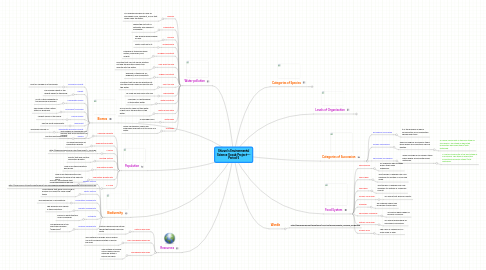
1. Biomes
1.1. Coniferous forest
1.1.1. Most of Canada is in this biome.
1.2. Desert
1.2.1. The Sahara Desert is the largest desert in the world.
1.3. Freshwater biome
1.3.1. Most of the freshwater in the world are in glaciers.
1.4. Grassland/ savannah
1.4.1. The middle of the United States is grassland.
1.5. Marine biome
1.5.1. Largest biome in the world.
1.6. Rainforest
1.6.1. Has the most biodiversity.
1.7. Temperate deciduous forest
1.7.1. The biome we live in.
1.8. Tundra
1.8.1. Has the least biodiversity.
2. Biodiversity
2.1. Abiotic factors
2.1.1. Are non- living things that never was living or will live.
2.2. Biotic factors
2.2.1. Living things that were once living or a piece of a living (or once living) thing.
2.3. Ecosystem biodiversity
2.3.1. The differences in ecosystems.
2.4. Genetic biodiversity
2.4.1. The differences in genes in the ecosystem.
2.5. Hotspots
2.5.1. Places on earth that are VERY biodiverse.
2.6. Species biodiversity
2.6.1. The difference in the plants and animals (organisms).
3. Population
3.1. Carrying capacity
3.1.1. The number of individuals of a species that an ecosystem can support.
3.2. Exponential growth
3.2.1. A sudden explosion of population growth.
3.3. J-curve
3.3.1. http://www.biologycorner.com/resources/J_curve.gif
3.4. Limiting factors
3.4.1. Events that help control population growth.
3.5. Population growth
3.5.1. How much the population has grown.
3.6. Population growth rate
3.6.1. How much the population will continue to grow in the years to come.
3.7. S-curve
3.7.1. http://mainland.cctt.org/biolab/graphs/S%20Curve%20Framed%20Gold%20as%20Gray%20WC.gif
4. Water pollution
4.1. Aquifier
4.1.1. An underground bed or layer of permeable rock, sediment, or soil that helps clean the water.
4.2. Desalination
4.2.1. Taking the salt out of saltwater and making it freshwater.
4.3. Erosion
4.3.1. The gradual wearing away of land.
4.4. Impermeable
4.4.1. Water can't get in it.
4.5. Inorganic pollutant
4.5.1. Example of these are heavy metals, ammoniea, and acidity.
4.6. Non-point source
4.6.1. Pollution that can not be pin pointed out and the pollution doesn't go directly into the water.
4.7. Organic pollutant
4.7.1. Example of these are: oil, degerant, and cosemetics.
4.8. Point Source
4.8.1. Pollution that can be pin pointed out and the polluion does go directly into the water.
4.9. Urbanization
4.9.1. To make an area more city-like.
4.10. Water pollution
4.10.1. "Damage" or "disturbance" in the Earth's water.
4.11. Water purification
4.11.1. A process to clean out the water or get rid of the pollution in the water.
4.12. Watershed
4.12.1. A drainage basin.
4.13. Wetlands
4.13.1. Areas like swamps, which are biodiverse and help a lot to purify our water.
5. Resources
5.1. Natural resources
5.1.1. Natural resources are natural things that people use from earth.
5.2. Non-renewable resources
5.2.1. Any material or energy source which can not be replaced within a human life span.
5.3. Renewable resources
5.3.1. Any material or energy source which can be replaced within a human life span.
6. Categories of Species
6.1. Endangered species
6.1.1. A species at risk of extinction.
6.2. Indicator species
6.2.1. Certain types of species who can show the overall health of the ecosystem by either of their presence or absence because these species are very fragile.
6.3. Pioneer species
6.3.1. Species that establishes itself at the start of succession.
6.4. Threatened species
6.4.1. A species in the near future, most likelyto become an endangered species.
7. Wordle
7.1. http://www.wordle.net/show/wrdl/1542125/Environmental_Science_%28Q%29
8. Levels of Organization
8.1. Organism
8.1.1. A living thing.
8.2. Population
8.2.1. How many of a living organism.
8.3. Community
8.3.1. A group of different organisms interacting with each other.
8.4. Ecosystem
8.4.1. A place where abiotic and biotic factors are interacting.
8.5. Biome
8.5.1. The geopraphic area with many ecosystem based on climate and elevation.
9. Food System
9.1. Decomposer
9.1.1. An organism which breaks down other dead organisms.
9.2. Food chain
9.2.1. The transfer of energy from one organism to another in a one line chain.
9.3. Food web
9.3.1. The transfer of energy from one organism to another in a web like format.
9.4. Primary consumer
9.4.1. An animal that feeds on plants.
9.5. Producer
9.5.1. An organism which can produces its own food.
9.6. Secondary consumer
9.6.1. An animal which feeds on primary consumer.
9.7. Tertiary consumer
9.7.1. An animal which feeds on secondary consumers.
9.8. Trophic level
9.8.1. The class of organisms in a food chain or web.
10. Categories of Succession
10.1. Ecological succession
10.1.1. It is the process in which communities of an ecosystem change over time.
10.2. Primary succession
10.2.1. When ecological succession takes place where an ecosystem NEVER existed.
10.2.1.1. A climax community is the final stage of succession. The stage in which the ecosystem becomes stable (until disturbed.
10.3. Secondary succession
10.3.1. When ecological succession takes place where an ecosystem was disturbed.
10.3.1.1. A climax community is the final stage of succession. The stage in which the ecosystem becomes stable (until disturbed.
